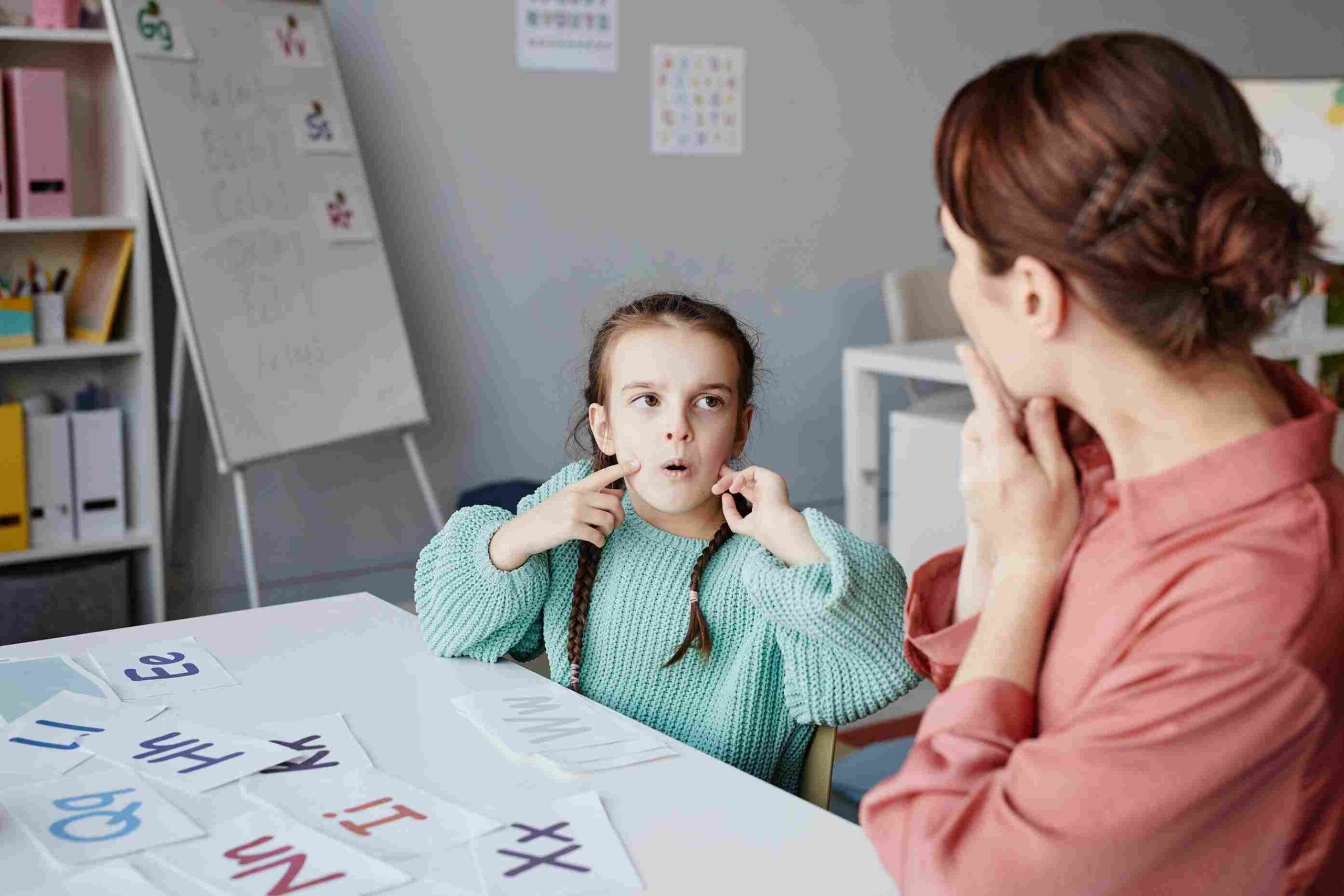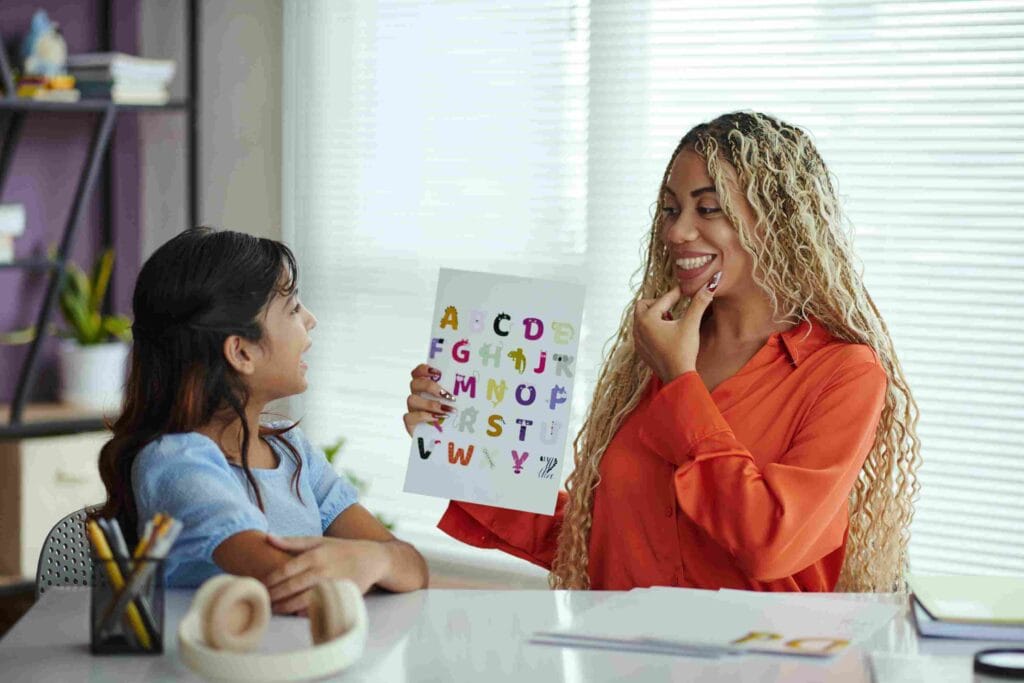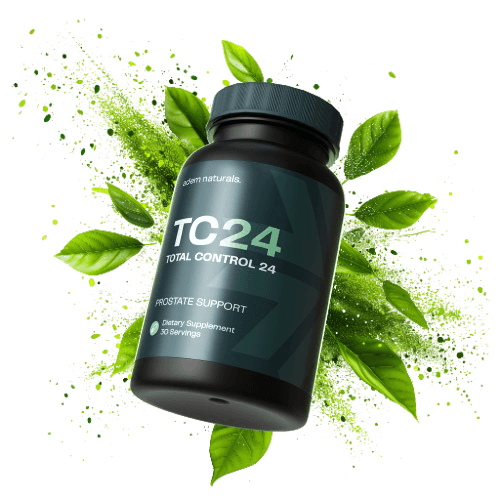
Table of Contents
Introduction – Dyslexia Is More Than Reading
Verbal dyslexia impacts countless children worldwide, yet many parents remain unaware of its far-reaching effects beyond reading difficulties. Did you know that your child’s struggle to follow verbal instructions or remember what they just heard might actually stem from this often-misunderstood condition?
When people hear the word “dyslexia,” they often picture reading and spelling struggle. True, dyslexia is a specific learning disability that impacts these skills, but it goes well beyond the written page and affects many areas of daily life.
Enter “verbal dyslexia” — also called phonological or auditory dyslexia — which affects specifically the ability to recognize and manipulate the sounds of spoken language (phonemes) and to connect them to letters (graphemes). This verbal element sets up invisible walls for children in classrooms, social scenarios, and general exchanges.
Consider your child who wants to engage in a class discussion but can’t express an idea, or who can’t remember what you just said because you spoke but didn’t write. These catastrophes have nothing to do with someone’s intelligence or effort — they come from how verbal dyslexia shows up in the world.
The emotional consequences can be devastating: lower self-confidence, fear that speaking up will get them in trouble, and even withdrawal from social interaction. But there’s hope. With insight into the cognitive roots of verbal dyslexia, along with concrete methods that you can use, parents have everything they need to help their children overcome these obstacles.
In this guide, we’ll explore the lesser-known verbal components of dyslexia, and examine its symptoms, cognitive origins, and most importantly — offer you practical and proven strategies to help bolster your child’s confidence in and outside the classroom.
The Phonological Core – Aligning Sound with Symbol
Phonological awareness is at the core of dyslexia – this is the ability to hear and work with the sound structures of spoken language. This defining trait is often the biggest challenge that children with verbal dyslexia face.
What Is Phonological Processing?
Phonological awareness includes the skills of identifying rhymes, breaking words into syllables and identifying individual sounds in words. These tasks surprise ly defy the children with verbal dyslexia, who appear otherwise normal or above average in intelligence.
“That’s a huge hurdle to overcome when you’re learning to read.” They may have trouble:
- Hear phonemes that are similar in sound (as /b/ and /d/)
- The word is broken into the sounds that make it up
- Combining individual sounds to create words
- Changing the sounds in words to make new words
The Sound-Symbol Challenge
Perhaps the most critical challenge in verbal dyslexia is a difficulty in mapping phonemes (sounds) to graphemes (written letters). This relationship between spoken and written language serves as a building block for reading and spelling development.
The link between letters and sounds is also something most children intuitively understand, but verbal dyslexic children learn to think of it as a confusing and unreliable relationship. The brain is forced to work far harder to make and maintain these connections, and reading can be slow, labored or inaccurate.
Beyond Reading and Writing
Critically, this phonological problem is not limited to difficulties with reading and spelling. The issue of processing underlying spoken words and how they are processed and produced also has a neurological underlying and a core problem that can overlap with this issue. Children might struggle with:
- Word retrieval (finding the correct word while speaking)
- Following multi-step verbal instructions
- How to pronounce unfamiliar or complex words
- The challenge of hearing alone vocabulary acquisition
Knowing the phonological core helps elucidate the reason traditional reading methodologies can be impotent and specialized, systematic teaching is so critical to verbal dyslexics.
The Impact of Verbal Working Memory
Verbal Working Memory in Dyslexia Explained
Another important cognitive function often problematic in people with dyslexia is Verbal Working Memory (VWM), or auditory working memory. This a foundational aspect of how children process, hold and manipulate spoken information in their mind.
According to a meta-analysis conducted by Swanson et al. It has been shown that children with dyslexia show consistent VWM deficits of around 1 standard deviation below those of their typically developing peers (Swanson, 2009, Journal of Learning).
A Little Science Behind VWM Capacity
VWM buffers the auditory information we process for a few seconds, which functions as a sort of mental workspace. Gathercole and Alloway (2008) found that for the population at large, VWM can be about 6-9 seconds in duration on average, but for those with dyslexia, VWM decreases to 2-3 seconds.
That much reduced capacity results in considerable learning challenges. A 2018 meta-analysis published in Scientific Studies of Reading concluded that VWM capacity directly predicts skills related to reading comprehension, accounting for as much as 45% of the variance in reading achievement scores.
How VWM Difficulties Manifest
Children whose VWM capacity is reduced tend to have difficulty with:
- Executes multi-step verbal commands
- Doing mathematical calculations in your head
- Focusing during language-based activities
- Keeping track of what they’ve read
According to Dr. Tracy Alloway, students with VWM impairments tend to find themselves mentally fatigued and overwhelmed more quickly than students without these deficits, as their cognitive resources are consumed at a more rapid pace.
The influence of assessment and reading comprehension
During dyslexia evaluations, assessment of VWM by professionals is done by means of specific tasks, including:
- Other common tasks are digit span tests (recalling sequences of numbers — forwards and backwards).
- Repeating made-up words (Nonword repetition)
- After deciphering more and more complicated orders
These assessments provide insight into how VWM limitations may be adversely impacting learning. Most critically, reduced VWM impairs reading comprehension because children simply cannot hold enough word sound information in their heads while processing the text. As they decode one word after another, earlier words often slip from memory before they can form meaning based on the fully formed sentence.
Awareness of this link between VWM and reading difficulties provides educators with the information they need to create interventions that minimize memory-based demands and increase capacity through targeted practice.

Serial Order Processing – More Than Just Word Recalling
One of the challenges in dyslexia is the sequence.
Most conversations about dyslexia—and all the various visualizations of it—center on this phonological realm, yet another part of cognition, no less fundamental, escapes notice: serial order processing. The presage of verbal short term memory we are most interested in — at least for the moment — is not about how much information we have presented, but the exact order in which it was presented.
STM that organizes in a serial order
Serial order short term memory (STM) allows us to hold a sequence of sounds, letters, words, and ideas in the proper order. For those with dyslexia, this ability to process sequentially is often compromised, leading to challenges that reach far beyond simple word recognition.
Significantly, this impairment in processing serial order can be dissociated from item recall ability in research. Someone with dyslexia may be able to recall every aspect but have a difficult time reordering them correctly. This struggle is not only limited to verbal information but also becomes associated with visuo-spatial serial ordering.
The Reading Connection
The role of serial order STM in the acquisition of reading is especially critical. Reading effectively demands a precision of sequential processing as we:
- Spell a word from left to right
- Recognize sequence of letters as printed version of stored word forms
- Conduct processing words in the right request to comprehend significance
When serial order processing fails, these elementary reading processes are more complicated and prone to mistakes.
Impact on Verbal Expression
Less understood is how sequential order problems limit verbal output. Here are some tasks that individuals with dyslexia often have difficulty with:
- Convey thoughts in a sequential order while talking
- Write a problem–reaction–solution sequence
- Retain correct word order in long sentences
- All sentences except the last one translate into “Follow multi-step verbal instructions”
And this is also the reason that you could have some children with dyslexia who seem completely disorganised in everything they say, but they have very good vocab and good conceptual understanding.
The Temporal Processing Link
The challenge of processing temporally organized information — anything that happens in time — is particularly pronounced for individuals with dyslexia. Such difficulties can result from biomarker problems that disrupt time-based encoding of sequential information, undermining both language comprehension and production.
However, making sense of these different serial ordering difficulties is yet another key piece of the complicated puzzle that is verbal dyslexia.
Understanding Expressive Language Difficulties in More Depth
Symptoms of Verbal Dyslexia That are Very Apparent
Reading challenges are often what comes to mind when we think of dyslexia. But the expressive language problems — how people verbally express what they think — can be just as important and usually much more obvious from day to day.
Examples of Expressive Language Disorders
Research by Snowling et al. specifically, a study in the Journal of Child Psychology and Psychiatry (2019) showed that up to 75% of children with dyslexia show some aspects of expressive language difficulty. These challenges, which may overlap with Language Processing Disorder (LPD) include:
Vocabulary Challenges
- Good comprehension, but very limited active vocabulary
- Achallenge making sense of and incorporating new language
- “We learned that verbal dyslexia in children was associated with 30 percent less learning of new words in relaxed exposure than their peers,” the researchers wrote in a 2020 study in Scientific Studies of Reading.
Word-Finding Difficulties
- Having multiple “tip-of-the-tongue” states
- Using filler words such as “thing,” “stuff” or “you know what I mean”
- German (2002) found that known words took 40% longer to retrieve in naming tasks in children with dyslexia
Issues of Structure and Organization
- Having difficulty with complex sentence structure and grammatical rules
- Trouble finishing thoughts or sentences
- Have issues structuring a coherent narrative of an idea
- In an exploratory study published in Developmental Science in 2018, 62% of dyslexic children had significant difficulties in narrative organization versus 12% of typically developing peers
Sound and Word Confusions
- Confusing similar-sounding words (mistaking “gentiles” for “genitals”)
- Combining different names/concepts (like “Savari” from “Savannah and Ari”)
- Pronunciation issues with multisyllabic words that persist
Beyond Intelligence
According to Dr. Sally Shaywitz’s groundbreaking research at Yale, these expressive language challenges exist separate and apart from intelligence. Indeed, her research shows that people with verbal dyslexia often score average to above-average on non-verbal reasoning tasks.
Being aware of these expressive difficulties allows parents and teachers to identify verbal dyslexia sooner, frequently before the child has received any formal reading instruction. This consciousness opens up the waters to the potential for earlier intervention when the brain is most receptive to therapy based on language and after the interfacing process has begun, limiting its impact on achievements in school and self–worth.
Strategies for Vocabulary and Word Retrieval
How to Shape Strong Word-Finding Skills
Despite the difficulties that children with verbal dyslexia experience in developing their vocabulary and retrieving words, this area displays a wonderful capacity for improvement with focused strategies to help. The following suggestions offer practical approaches to support your child’s verbal expression and confidence.
Vocabulary Building Activities
Building your child’s vocabulary adds “hooks” for him to hang words on and communicate ideas clearly:
- Build themed groups of words about your interests (space, animals, feelings) and review through games and conversation
- Practice describing objects in detail, encouraging the use of specific adjectives instead of cookie-cutters words like “nice” or “good”
- Make car rides and waiting times more stimulating by playing word association games, linking words by category, sound, or meaning.
- Read a variety of materials aloud together, stopping to discuss interesting or unfamiliar words
- Create a personal dictionary that your child adds to, recording new vocabulary and illustrating things they discover
Techniques for Retrieving Words Effectively
When words seem “stuck,” here are some strategies that can help unlock them:
- Use semantic networking and describe the function, appearance or kind of the word (“It’s round, you bounce it, you use it in basketball…”)
- Gestures and Movement: Use gestures and movement to create additional memory cues when learning new words
- Use word webs to visually link associated terms and reinforce pathways in the brain
- Rehearse timed category generation — “Name as many animals as you can think of in 30 seconds”
- In absence of the word, teach circumlocution skills, where your child describes the missing word to work around it
Methodological Orientation and Tools
Other supports may support word-finding as well:
- You have only one use of thesauruses (digital or physical use) to playfully examine word choices and broaden expression
- Divide complex words into chunks based on meaning (prefix, root, suffix)
- Try memory aides such as acronyms, songs, or visual links for frequently difficult words
Not only do these strategies strengthen vocabulary and word retrieval, but they also bolster your child’s confidence with words, allowing your child to feel empowered with language.
Strategies for Structuring and Sequencing Language
How to Build Strong Foundations of Communication
Verbal Dyslexia is another more verbal expressive form of dyslexia where children have difficulty organizing their thoughts and using structurally correct language. These strategies specifically can aid them in formulating clearer and better organized verbal expression.
Improving Sentence Structure
A strong foundation in syntactic awareness supports children in writing their ideas with greater precision:
- Begin by deploying simple frameworks that utilize basic subject-verb-object structures and then build out from them
- Now work with the topic sentence moving it up to your flipping cards…
- Join together related simple sentences with conjunctions such as “and,” “but” or “because” to practice sentence combining
- Start with a simple sentence and take turns with your child expanding it by adding adjectives and adverbs — that’s sentence expansion.
- Record and playback sentences so your little one can hear and analyze their SyntaxSies.
Organizing Thoughts for Speaking
These techniques assist children in preparing and organizing their verbal responses:
- Teach the “W questions” framework (Who, What, Where, When, Why) to be used as a mental checklist before answering questions
- Graphic organizers used before the discussion of complex topics, such as mind maps or simple outlines
- Use the “beginning-middle-end” Leela or the “start-move-end” targets for playing stories or explaining things
- Using the statement “dot points” – your child identifies 2-3 key ideas and builds on those
- Introduce first, next, finally transition word lists to connect ideas logically
Addressing Sequencing Issues
This is a short list of how strengthening sequential processing aids both comprehension and expression:
- Talk out daily sequences like morning routines or recipe steps
- Play “what comes next” games in familiar sequences and stories
- Make comic strips that can be sequenced, and then described orally
- Provide opportunities for practicing retelling with a clear setting, problem-and-solution sequence.
- Provide sequence chains with pictures or written cues to support verbal retells
Memory-Supporting Techniques
- Promote verbal rehearsal — Encourage your child to say sentences out loud when getting ready to talk
- Meet clicker training the socialisation game: A rhythm and movement helps to reinforce the sequence of longer verbal responses
- If they practice, record the practice sessions so they can hear their progression over time
Other methods such as these improve the structure of language, sequencing and overall skills of communication, giving children the confidence to express their ideas.
The Emotional and Social Landscape
Understanding the Hidden Impact of Verbal Dyslexia
While the cognitive aspects of verbal dyslexia are increasingly recognized, the emotional and social dimensions often remain in the shadows, despite their profound impact on a child’s wellbeing and development
The Emotional Weight
High social involvement combined with very high social anxiety can lead to social avoidance Research (2021) indicates significantly higher rates of social anxiety (42%) in children with verbal dyslexia compared to typically developing peers (11%) (pub, 2021 in Journal of Learning Disabilities). You do not need to be well spoken and communicate eloquently.
- Continual frustration when swerving into the dead-end sentences
- So-called anticipatory anxiety before group calles or class
- That was me before I fully understood the feeling of embarrassment when using incorrect or foreign words
- Reduced self-image when communication troubles continue
A longitudinal study by Livingston et al. (2018) revealed that by adolescence, 38% of individuals with verbal dyslexia reported avoiding social situations that required substantial verbal interaction.
Social Interaction Challenges
The social functioning ripple effects can be huge:
- Struggling to keep up with fast-paced discussions
- Having trouble with subtle social cues or pragmatic language skills
- Awkward pauses while trying to find words
- Coping behaviors such as verbose language to hide struggles
- Perfectionistic inclinations that stifle impulsive sharing
Strategies for Supporting Emotional Well-being
Validate their feelings and Approach them with Empathy
- Acknowledge frustrations without dismissing them
- Create safe spaces for expressing communication challenges
- Connect with support communities where experiences are shared
- According to Alexander-Passe (2015), children whose difficulties were openly acknowledged showed 27% better emotional adjustment scores
Cultivating Confidence In Communication
- Positive Reinforcement: Reward good interactions, even if at a small scale
- This will help you use and enhance your strengths from a communication style perspective (creativity, humor, storytelling).
- Train under low-stakes situations before performing in high-stakes situations
- Interventions to build confidence cut avoidance behaviours up by 40%, research found
Developing Social Resilience
- Structured Practice: Teaching specific pragmatic language skills
- Role-play common social scenarios to develop automaticity
- Use diplomatic phrases to ask the other party for clarification
- Start practicing turn taking in conversations with an increasing number of people
Communication Anxiety Management
- Guide relaxation techniques for communication settings
- Seek professional help if anxiety severely disrupts everyday life
- Promote mindfulness strategies that counteract perfectionist thoughts
In fact, what we do to address those emotional and social dimensions is just as important as addressing the cognitive aspects of verbal dyslexia; a combo that together forms a foundation for confidence and success that lasts a lifetime.

Professional Support and Practical Interventions.
How to move towards giving proper support
Home-based strategies are incredibly helpful, but, given the complex nature of verbal dyslexia, professionals are also needed to treat the condition effectively. Research consistently shows that intensive, specialist-led interventions determine markedly better outcomes for children with language-based learning differences.
The Simple Power of Professional Evaluation
And a comprehensive assessment precedes any effective intervention. According to a meta-analysis published in the Journal of Speech, Language and Hearing Research (2019), children receiving targeted interventions tailored to needs identified through detailed assessments made 42% more improvement than those receiving generic language input.
According to the International Dyslexia Association evaluations that specifically test for:
- Phonological processing abilities
- Verbal working memory capacity
- Rapid automatic naming skills
- Expressive and receptive language proficiency
Speech-Language Pathologists: Specialists in Verbal Dyslexia
While SLPs possess specific skills for dealing with verbal language difficulties. According to a ground-breaking study (Snowling and Hulme, 2021) SLP interventions resulted in statistically significant improvements in:
- Phonological awareness (average 35% improvement)
- Word retrieval fluency (27% improvement)
- Narrative organization skills (31% improvement)
- Pragmatic language abilities (24% improvement)
These specialists create personalized therapy plans that address the unique combination of strengths and challenges for each child.
Multisensory approaches: Activating multiple pathways
Birsh and Carreker’s study (2018) found that multisensory interventions (involving visual, auditory, kinesthetic, and tactile systems together at the same time) resulted in 30% greater retention of language concepts than a traditional approach. Effective approaches include:
- Incorporating movement into vocabulary learning
- Using tactile materials for word-building
- Pairing verbal information with visual representations
- Incorporating rhythm and music into language practice
Educational Accommodations and Technology Support
Formal educational supports in the form of IEPs or 504 plans offer important accommodations that help level the playing field:
- Allow additional time to respond verbally
- Various types of assessment formats
- Visual reducers for verbal tasks
And assistive technology provides huge support. In a study published in 2020 in Assistive Technology, researchers found that computer software that recognizes and transcribes speech produced 40 percent higher-quality written expression for students with verbal dyslexia, while special language apps helped reinforce therapy treatment goals between student sessions.
These professional interventions are further supported by a caring, structured environment at home and school, providing consistency and practice — both of which are absolutely necessary for the development of language and building confidence.
Thriving Beyond the Challenges
Embracing the Unique Path Forward
Verbal dyslexia can be presented with some real challenges, but it is important to look at it as a learning difference and not as a limitation on potential or intelligence. Individuals with verbal dyslexia have frequently excelled as writers, speakers, entrepreneurs and leaders in all walks of life.
Progress Through Understanding and Support
Read about how, with the right knowledge, specific strategies and ongoing support, people with verbal dyslexia can achieve extraordinary outcomes in their ability to communicate. Neuroplasticity of the brain means that with enough focused practice of the right techniques, we can form new neural pathways that reinforce the areas we find difficult.
Building on Strengths and Celebrating Success
Better yet, when we focus on strengths vs. deficits, we create a platform for confidence and success — perhaps most importantly. Those with verbal dyslexia often excel at:
- Visual-spatial thinking and three-dimensional reasoning
- Creative problem-solving and thinking outside conventional boundaries
- Connecting seemingly unrelated ideas in innovative ways
- Empathy and emotional intelligence that enriches relationships
- Persistence and resilience developed through overcoming challenges
- Quick wit and wordplay that emerges as language skills develop
- Storytelling abilities that captivate listeners
The Evolving Landscape of Support
Neuroscience is constantly advancing our understanding of brain function and many effective interventions have been developed over the years. And though the world of verbal dyslexia struggles to find the latest approaches, new technologies, teaching structures, and support systems arise every day, attaining a better, better answer to itself.
Embracing the Journey
The road is not always easy, but with advocacy, the right support, and a strengths-based approach, children with verbal dyslexia can learn to harness the skills and confidence they need to use their individual voices effectively. By simply welcoming this journey—success and adversity alike—we give our own children the opportunity to find success their own way, and we equip them with the resilience to carry them through the rest of their lives.
Always keep in mind that many of history’s preprocessing thinkers and innovators, based on their different way of processing information in the world, made some of the greatest contributions.
Experience cognitive clarity like never before with Pineal Guardian – the revolutionary brain health supplement in convenient drop form. Each precisely formulated drop delivers powerful brain-supporting nutrients directly to your system, enhancing focus and mental sharpness when you need it most. Click now to discover how these premium-quality drops can transform your cognitive wellness routine and unlock your brain’s full potential.

Conclusion
Understanding verbal dyslexia requires getting through a web of cognitive complications that influence the way individuals code and express language. These difficulties between the foundational phonological awareness problems of serial order processing rest on working memory and expressive language can dramatically alter the way a child communicates and interacts with the world around them.
But as we have discussed throughout this article, verbal dyslexia is very manageable if you have the correct awareness, tools, and support system in place. Since the brain’s plasticity helps to build neural pathways through that repetition with the right techniques, the act of practice can create those sites of semantic action and reinforce them over time, as communication improves.
Above all, a child’s intelligence, creativity or potential are nototypes of verbal dyslexia. People with dyslexia have incredible skills like visual thinking, problem-solving, creativity, and emotional intelligence that can become powerful advantages when identified and built on.
As we embark on the path of supporting them, we continue to do so with patience, consistency, and without losing faith: faith in logographic learning, in syllabic learning, in sound-letter connection. And so, with every small victory—getting a tough word quickly, organizing his thoughts a little better, feeling a little more comfortable in social settings—your child is one step closer to finding their voice and releasing their full potential.
If you would like to discover more supportive resources that could enhance your child’s confidence, communication and more, check this one out THE PINEAL GUARDIAN. The information and insight in this article is only the tip of the iceberg, so if you want actionable tips, and expert advice to help your child thrive in communication, be sure to check out this must-have resource!
Based on this understanding, with consistent support, and with appropriate resources, your child will not only manage the challenges that attach to verbal dyslexia but can truly thrive, building the skills and confidence to share his or her unique gifts with the world.






